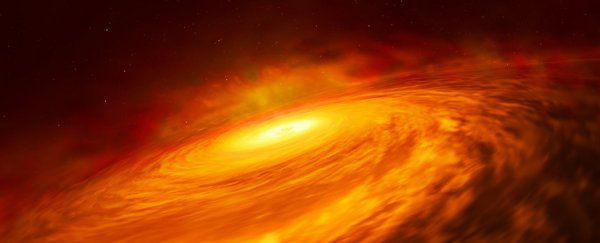Something strange is happening 130 million light-years away in spiral galaxy NGC 3147: there's a thin disc of material surrounding its small and 'starving' black hole that's a complete surprise to astronomers.
Discs like the one spotted in NGC 3147 – made up of gas, dust and other debris pulled into the black hole's orbit – are normally found in more active galaxies, with bigger black holes, that appear much brighter to our telescopes.
Usually, the more gas there is being trapped by a black hole, the brighter the accretion disc appears, and the more energy is released in a burst of electromagnetic radiation known as a quasar. But the accretion disc emanating from NGC 3147 appears to defy that trend.
That's because the black hole is relatively faint - the astronomers expected to see something more like a "puffed up doughnut" rather than a pancake-like disc.
"The type of disc we see is a scaled-down quasar that we did not expect to exist," says astronomer and the study's first author Stefano Bianchi, from Roma Tre University in Italy.
"It's the same type of disc we see in objects that are 1,000 or even 100,000 times more luminous. The predictions of current models for very faint active galaxies clearly failed."
A deep space observation of this type is only possible thanks to the super-powerful optics of the Hubble telescope, and as Bianchi says, it could help in our understanding of how less active galaxies operate.
In particular, the Hubble Space Telescope Imaging Spectrograph (STIS) instrument was able to block out the light from the surrounding galaxy to observe the speed, temperature, and other characteristics of the matter inside the swirling disc.
Besides being an anomaly in the first place, the disc is also so close to its black hole's gravitational field that its light is being bent out of shape and intensified, making it an even more fascinating find.
"This is an intriguing peek at a disc very close to a black hole, so close that the velocities and the intensity of the gravitational pull are affecting how we see the photons of light," says Bianchi.
That means the system gives astronomers a rare opportunity to put the theories of relativity proposed by Albert Einstein to the test. The light visible from the black hole disc in NGC 3147 might well help in an analysis of both general relativity and special relativity – how space, time, light and gravity fit together.
It's also another example of the cosmos continuing to throw up the unexpected – especially when it comes to the mysteries that are black holes.
Ironically, astronomers originally selected NGC 3147 as a candidate for proving discs couldn't form around smaller black holes, only to have the idea flipped on its head.
"We thought this was the best candidate to confirm that below certain luminosities, the accretion disc doesn't exist anymore," says astronomer Ari Laor, from the Technion-Israel Institute of Technology.
"What we saw was something completely unexpected. We found gas in motion producing features we can explain only as being produced by material rotating in a thin disc very close to the black hole."
The research has been published in the Monthly Notices of the Royal Astronomical Society.
